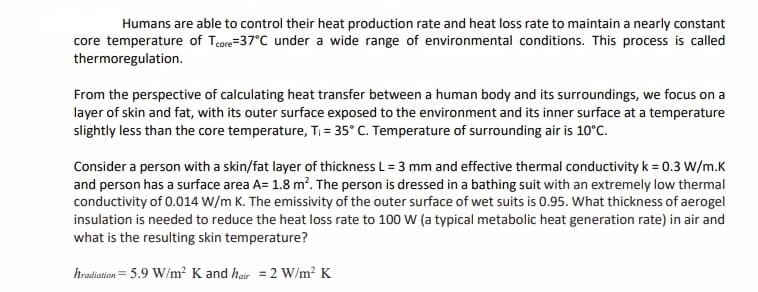Humans are able to control their heat production rate and heat loss rate to maintain a nearly constant core temperature of Tcore=37°C under a wide range of environmental conditions. This process is called thermoregulation. From the perspective of calculating heat transfer between a human body and its surroundings, we focus on a layer of skin and fat, with its outer surface exposed to the environment and its inner surface at a temperature slightly less than the core temperature, T; = 35° C. Temperature of surrounding air is 10°C. Consider a person with a skin/fat layer of thickness L = 3 mm and effective thermal conductivity k = 0.3 W/m.K and person has a surface area A= 1.8 m?. The person is dressed in a bathing suit with an extremely low thermal conductivity of 0.014 W/m K. The emissivity of the outer surface of wet suits is 0.95. What thickness of aerogel insulation is needed to reduce the heat loss rate to 100 W (a typical metabolic heat generation rate) in air and what is the resulting skin temperature? hradiation= 5.9 W/m² K and hair = 2 W/m2 K
Energy transfer
The flow of energy from one region to another region is referred to as energy transfer. Since energy is quantitative; it must be transferred to a body or a material to work or to heat the system.
Molar Specific Heat
Heat capacity is the amount of heat energy absorbed or released by a chemical substance per the change in temperature of that substance. The change in heat is also called enthalpy. The SI unit of heat capacity is Joules per Kelvin, which is (J K-1)
Thermal Properties of Matter
Thermal energy is described as one of the form of heat energy which flows from one body of higher temperature to the other with the lower temperature when these two bodies are placed in contact to each other. Heat is described as the form of energy which is transferred between the two systems or in between the systems and their surrounding by the virtue of difference in temperature. Calorimetry is that branch of science which helps in measuring the changes which are taking place in the heat energy of a given body.

Trending now
This is a popular solution!
Step by step
Solved in 2 steps with 1 images







